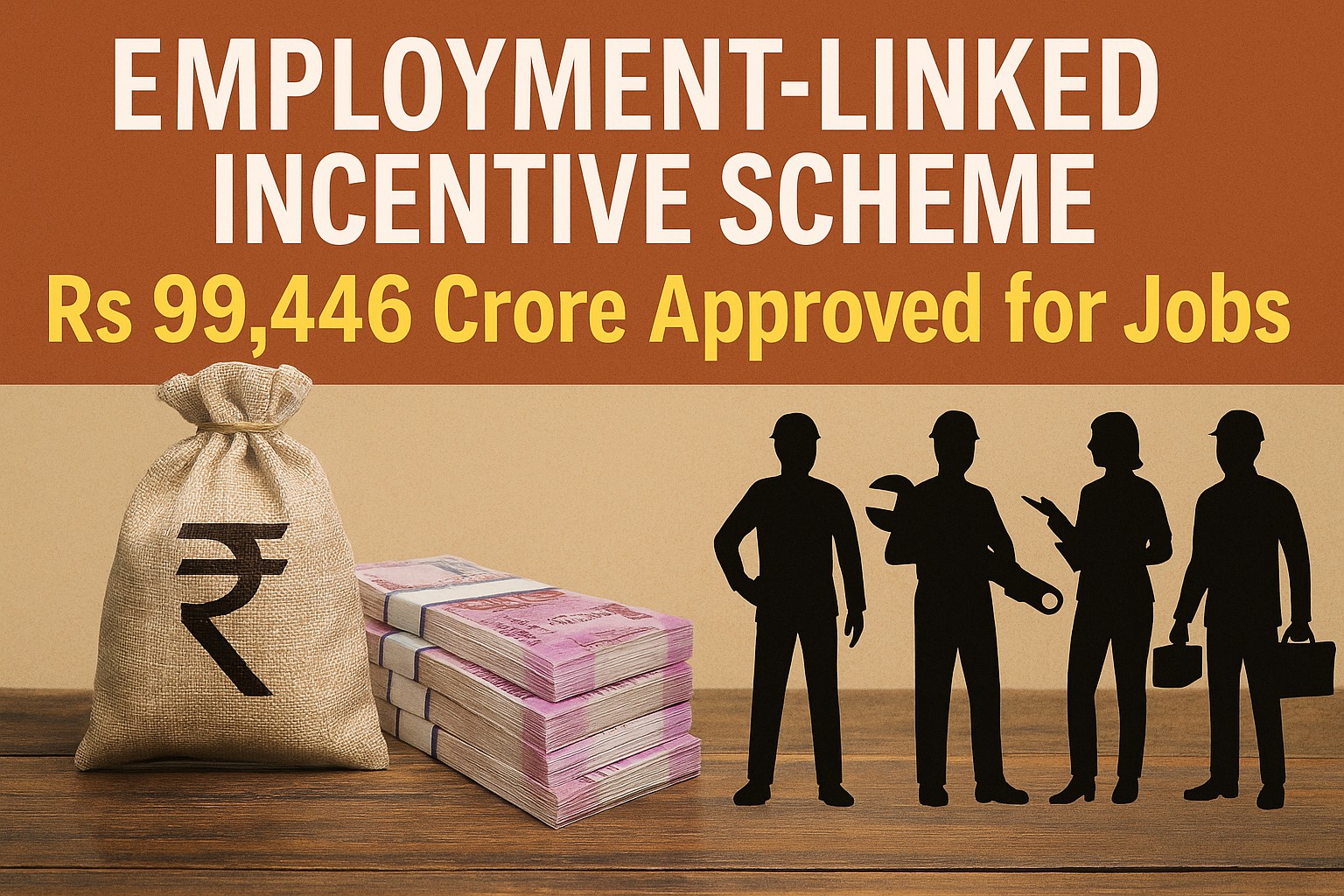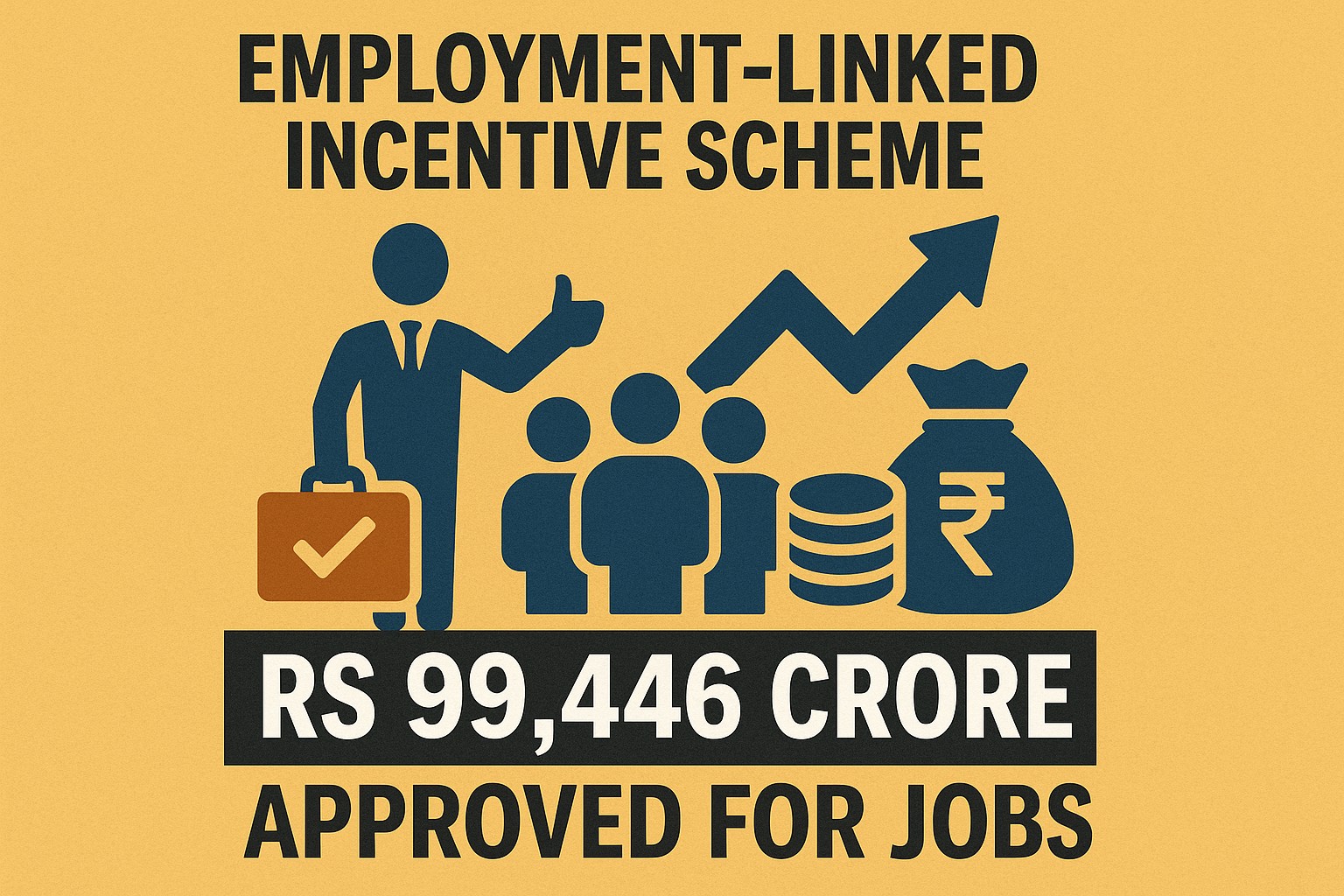Employment-Linked Incentive Scheme (ELI) has been approved by the Indian Cabinet with a substantial allocation of Rs 99,446 crore, marking a landmark initiative to generate 3.5 crore jobs across India in the next two years. The scheme aims to provide a major boost to the country’s employment sector, targeting various industries such as manufacturing, technology, textiles, and services. With India still recovering from the effects of the COVID-19 pandemic, this move is expected to create long-term, stable job opportunities for the workforce, particularly for the youth.
Key Features of the Employment-Linked Incentive Scheme
-
Total Financial Outlay: The scheme has been allocated Rs 99,446 crore, ensuring substantial government backing for job creation.
-
Job Creation Target: Over 3.5 crore jobs are expected to be generated within the next two years, particularly in manufacturing, textiles, electronics, and services.
-
Eligibility for Incentives: Companies and industries that hire additional employees will be eligible for financial incentives under the scheme, encouraging job creation across multiple sectors.
-
Focus on Youth Employment: The scheme is particularly designed to benefit young professionals aged between 18 and 30, addressing the rising youth unemployment issue in India.
-
Subsidies for Industries: Small and medium-sized enterprises (SMEs) will receive support to hire more employees, providing much-needed relief to these businesses.
Government’s Strategic Role and Industry Collaboration
The Indian government will work in partnership with both state governments and private companies to ensure the effective implementation of the Employment-Linked Incentive Scheme. With a focus on incentivizing businesses to create jobs, the government aims to provide financial assistance to industries that are crucial for economic recovery and growth.
This collaboration will particularly benefit small and medium-sized businesses, which have faced financial constraints in hiring new workers. The financial incentives will ease the burden on these businesses, allowing them to expand operations and offer employment to a broader section of the population.
Economic Impact and Benefits of the ELI Scheme
The Employment-Linked Incentive Scheme is a vital step toward addressing the unemployment crisis in India, particularly after the economic downturn caused by the COVID-19 pandemic. With millions of jobs lost during the crisis, the scheme provides much-needed stability and growth to India’s labor market.
The scheme’s impact will go beyond creating jobs – it will also stimulate consumer demand, boost GDP growth, and help improve the overall economic outlook of the country. As new jobs are created, workers will contribute more to the economy through consumption and taxes, which will further enhance the government’s ability to reinvest in infrastructure and public services.
Key Sectors Benefiting from the ELI Scheme
The scheme will impact a variety of sectors, including:
-
Textile Industry: India’s textile sector is poised for growth with the ELI scheme, as it is one of the key areas identified for job creation (source).
-
Electronics Manufacturing: The electronics industry, a growing sector in India, will see significant expansion, providing thousands of jobs in production, design, and technical roles (source).
-
Technology Services: As India continues to strengthen its IT sector, the ELI scheme will support the creation of tech-related jobs, including in software development, cybersecurity, and digital marketing.
-
Healthcare and Logistics: These sectors are also expected to witness growth in hiring, supporting the country’s infrastructure development.
Challenges and Implementation
Despite the promising outlook, experts highlight the challenges in ensuring efficient implementation of the scheme. The government will need to coordinate with industry bodies and labor unions to guarantee that job creation aligns with quality standards. Additionally, ensuring that jobs are stable, well-paying, and aligned with India’s long-term economic goals will be essential to making this initiative a success.
Another challenge is the skills gap. Many workers, particularly in rural areas, may not have the skills required for the newly created jobs in high-tech industries. As a result, the government will need to invest in skills development and vocational training programs to ensure that India’s workforce is ready for these emerging roles.
Youth Employment Focus: A Step Toward Inclusivity
One of the key highlights of the Employment-Linked Incentive Scheme is its focus on youth employment. The scheme is expected to provide job opportunities for young professionals, who have been particularly hard-hit by unemployment. According to government estimates, more than 50% of India’s population is under the age of 25, making the youth employment issue even more critical.
By targeting younger workers, the government hopes to provide them with long-term career opportunities, offering a clear path toward financial independence and stability. The initiative aims to bridge the urban-rural divide in job opportunities, ensuring that both urban centers and rural areas benefit equally from the job creation process.
Expert Opinions on the ELI Scheme
Industry experts have lauded the Employment-Linked Incentive Scheme for its potential to drive substantial economic growth. Dr. Raghuram Rajan, former Reserve Bank of India Governor, has praised the government’s efforts in addressing unemployment through innovative policies like the ELI scheme. “The focus on job creation is essential for reviving economic growth, particularly in the wake of the pandemic,” he stated.
Similarly, experts from the Confederation of Indian Industry (CII) have emphasized that the scheme will not only support job creation but also enhance the competitiveness of industries by improving their labor force (source).
Conclusion: A Pathway to Long-Term Growth
The Employment-Linked Incentive Scheme stands as a powerful tool in India’s economic recovery, creating millions of job opportunities and boosting the country’s GDP. With a focus on youth employment and sectoral growth, this initiative will have a lasting impact on India’s economic trajectory. However, its success will depend on effective implementation, ongoing industry support, and ensuring that the new jobs created meet the needs of India’s evolving economy.


